- Know what
are Ragamala Paintings, what type of Raga does a painting represent, Iconographic
journey of Ragamala, what are the painting styles of Ragamala?
Music and
painting have been the mediums of worship and pleasure since the ancient times,
since both spring out from the deepest corners of the heart and soul. Visualizing
music has been attempted by both Indian and western scholars, poets, painters
and architects. While Matanga (ancient musicologist) in his treatise Brihaddeshi Matang depicted Raga, the
Indian melodic modes with Meditative Poetry Ragadhyānas, the western scholar Gowth connected architecture with music saying "Architecture is but frozen music”.
Over the centuries, 'Ragamala' paintings evolved as a distinct style of Indian miniature paintings which depicted, Indian music and poetry with imagery, in an attempt to capture the essence and the form of the raga in its visual form which still continues to captivate it's onlookers.
'Raga' connotes to a melodic mode that can colour the mind with the mood or feelings of delight. The series of miniature paintings which are iconographic representations of a set of ragas were thus called the 'Ragamala' meaning the 'Garland of Raga'.
These
paintings represent specific moods of Love, Devotion, Passion, Happiness and
celebration of life, as its prominent themes, particularly depicting the ragas
of the Hindustani (north Indian) classical music style.
Tracing back the iconographic journey of Ragamala, we find that it began with the 'Ragadhyana' created by Matang in Brihaddeshi (classical Sanskrit texts on Indian Classical music attributed to Matang Muni 6th-8th century) wherein the term “Dhyana” is derived from dhyai i.e. to meditate upon, imagine or call to the mind. Thus, Ragadhyanas were short poetic verses
or songs in Sanskrit which were designed for the contemplation of the gods and
Goddesses who were associated to a particular Raga. The texts of these verses
were sacred and described the features and attributes of a particular deity.
After
Brihaddeshi we find them in the 13th century treatise Sangita Ratnakar by Sharandev which again connects each raga to a deity. The pictorial descriptions of melodic modes were first found in Saṅgitopaniṣat-saroddhara by Sudhakalasa (1324). We also find the paintings in the Kalpasutra manuscript (1475) from the Jayasiṃhasurji collection of Indore, illustrating particular ragas, which correspond to the dhyanas of the Saṅgitopaniṣat-saroddhara. This was the earliest known series of raga mala paintings which included 42 paintings describing 'Ragas' according to the gender terminology as per the ancient raga/bhaṣa characterisations. Thus, a detailed study of the dhyana texts provides a substantial understanding of the history of the Ragamala tradition.
The
initial Ragamala paintings primarily depicted the six principal ragas namely
Bhairav, Deepak, Sri, Malkauns, Megh, and Hindol, each one of which was
designated a particular season and a time of the day from dawn, dusk, night as
per the ancient time theory. Thus, Raga Bhairav was sung in summer, Deepak in monsoon,
Sri in autumn, Malkauns in early winter, Megha in winter, and Hindola in
spring.
We often find the Raga, its mood and season written as poetry on the margins of the Ragamala paintings. Raga 'Bhairava' was depicted as 'Lord Shiva' sitting on the Nandi as his Vaahana (vehicle), Raga 'Megha' was pictured as 'Lord Vishnu' adorning a flower garland, with a peacock at his feet, Raga Sri is depicted as Devi.
Since ancient times, an analogy is given of a family of Ragas where 'Ragas' are paired with female musical melodies called Raginis to give birth to children. Each Raga would have 6 'wives', (Ragini's), along with numerous 'sons' (Ragaputra) and 'daughters' (Ragaputri) and even 'daughters-in-laws'( Ragaputra vadhu).The idea is to understand the Raga creation in Indian classical music, which happens by changing permutations of the musical tunes/ modes to create new Ragas. While, those matching the musical tunes were considered to be in the same family.
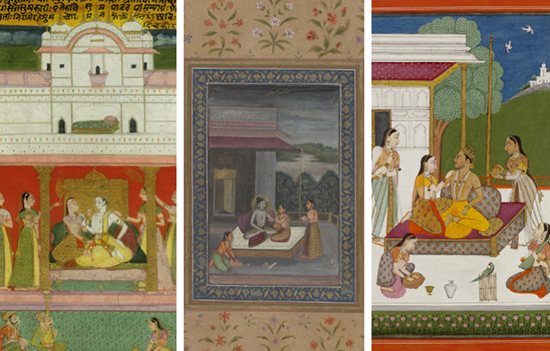 Depiction of Raga Bhairava (associated with Shivji).
Depiction of Raga Bhairava (associated with Shivji).
Raga
Bhairav which is an early morning melody associated with Lord Shiva. It
symbolises a purifying experience, while in some paintings he is shown as Shiva
with a divine feminine applying sandalwood onto his body. In others he is
depicted as kala bhairava who has white complexion, has one head and eight
hands. He dones an antelope skin, rides a bull and adorns a serpent, trident
and a human skull. There have been many styles of miniature paintings in which
we find the depiction of Raga bhairava in the Bikaner, Mughal and Hyderabad
styles.
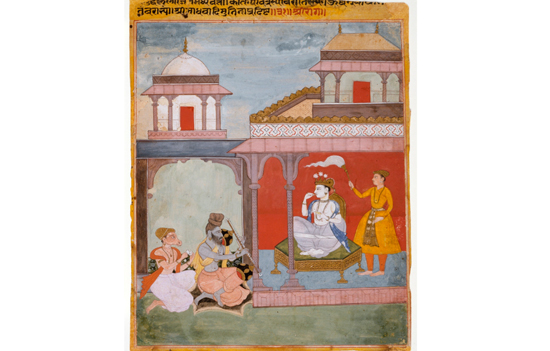 Raga Shree.
Raga Shree.
Ragamala
Shree is an evening melody which evokes a mood of happiness, relaxation and
sometimes even nostalgia. The raga is also associated with autumn and the
harvest season. The Ragamala shree depicts an evening concert while Sage Narada
and Tumburu (grandson of Brahma) play music to entertain the king.
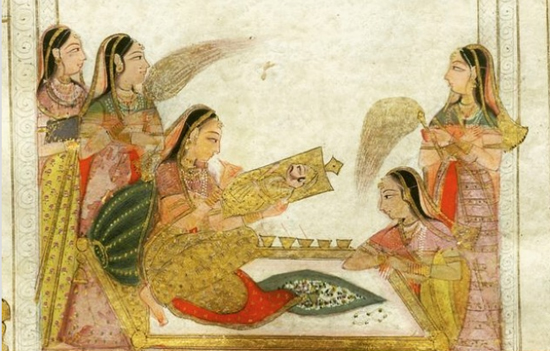 Dhanashri Ragini
Dhanashri Ragini
This
painting represents the melancholy the very mood of the raga Dhanashri, an
evening melody which highlights the pain of a nayika who misses her beloved and paints his picture.
In 1591
Keshava Dasa, in his treatise on love Rasikapriya,
through his poems depicted the eternal love of Radha and Sri Krishna. The poems
were later illustrated into Ragamala paintings showing different stages of
their courtship ranging from romantic moments to mutual disagreements, and
eventual reconciliations between the lovers, creating a story through the
series.
During the 11-17th centuries the visual depiction of the 'Ragas' along with their 'Deities' came in vogue representing the Ragamala paintings. Thus, dating from around the year 1475 to the end of the 19th century, the Ragamala painting tradition refers to some 3000 miniature paintings created in many different styles and schools.
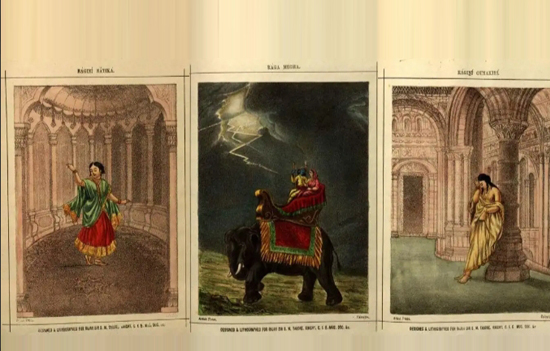 Ragamala depicting seasons.
Ragamala depicting seasons.
Over the
centuries, Ragamala paintings received Royal Patronage by various Kingdoms
which reached its peak by the 16-17th centuries. The style of miniature
painting started spreading across the Mughal Empire as painters accompanied their
patrons to various postings. The form eventually evolved into many distinct
styles of paintings viz. Mughal Ragamala, Deccan Ragamala, Nepalese and Pahari
Ragamala, Rajasthan or Rajput Ragamala all representing an aesthetic
amalgamation of Music, Art, and Poetry.
Looking at the evolution of themes we find that by the middle of the 16th century, the narrative of the Ragamalas completely changed (perhaps due to Muslim rule) from the depiction of divine icons to a more mundane human life, as scenes from daily life became more popular. The artist's focus became the mundane human life portraying expressions of love or longing for one's love or deity, amid exotic landscapes and architectural surroundings.
The
unifying subject of Ragamala paintings became love, which evoked a range of
specific emotions (Rasa) corresponding to a Raga. Each painting personified a
Raga with a distinct colour and a mood, wherein a verse described a story of
the union and passions of the lovers (Sambhog
Sringar Bhav between the Nayaka and Nayika (hero and heroine as the male
and female protagonist of the story) which explored both the musicality (Raga)
and analogous imagery.
A bit
about each style of Ragamalas.
Rajasthani Miniature Ragamala
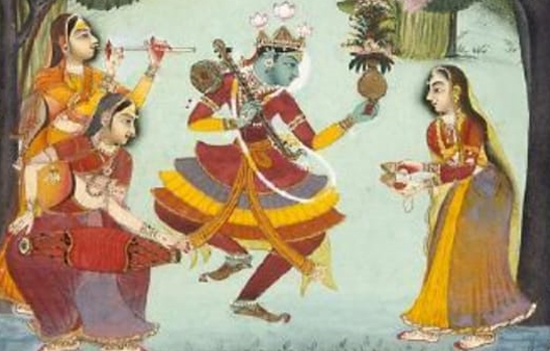 Vasanta Ragini.
Vasanta Ragini.
The
Rajasthani style included a depiction of Radha and Krishna, the divine lovers
beautifully portraying their mystic love. These paintings have highly
exaggerated features with large almond-shaped eyes, long necks, and fingers.
Mughal Ragamala
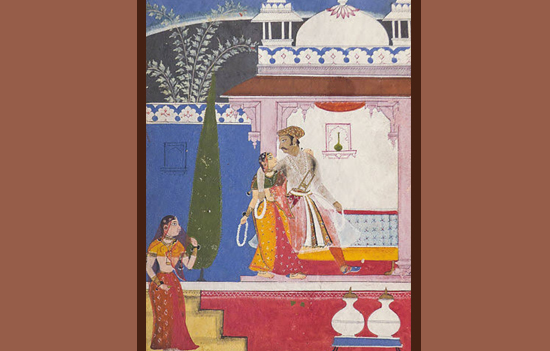 Malavi Ragini
Malavi Ragini
The
Ragamala paintings created during the era of Mughal king Akbar and Jahangir
were characterised with visual simplicity, illustrating the refined culture of
the Rajput and Mughal courts, and scenes from society during the power change.
Looking
at the colour combinations in the paintings we see pale yellow backgrounds,
pale blue skies, dark green trees and cypresses with pale green and yellow
leaves, and slate grey rivers, which gave a sense of serenity to the
landscapes. The houses are shown in white with pink pillars, red doors, and
pale green rooftops. The costumes coats, skirts, and blouses were painted in
red, orange, mauve, and yellow worn by men and women with complexions depicted
with pink or mauve. Women wore transparent white or silver sarees with exquisite
jewellery, studded necklaces, gold rings, anklets, bangles, waistbands, while
men wear fine coats and jammas.
Ragamala
paintings that survived the ravage of time are only 36-42 in number which we
are still preserved in museums. Some of the prominent Ragamalas Paintings which
are still well preserved include Ragas: Malhar, Megha, Sri, Deepak, Asavari,
Pancham, Maligora, Dhanashri, Varari, Gunkali, Nata, Bhairavi, Bhivasa, Hindol,
Devkali, Kanhara, Malkauns, Bilawal, Bairon, Shyam Gujari, and Vasanta.
The
intricate pieces of exquisite melodic paintings were created as loose-leaf
folios stored in a portfolio. They were either circulated within the inner
court circles of the Royals who commissioned them or were exchanged and viewed
as pleasurable past times by their Queens in the Zenana Khana and the
courtiers, and their guests who were admirers of painting, poetry, and music.
We also find some Ragamalas painted as murals in the private quarters of the
palaces.
Deccan Ragamala
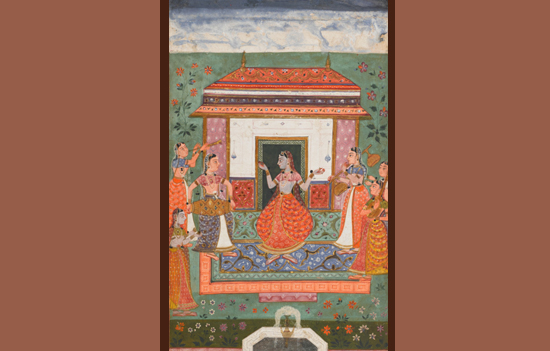 Megha Ragini. This depicts a maiden awaiting her lover in the rainy season.
Megha Ragini. This depicts a maiden awaiting her lover in the rainy season.
In the
Deccan, the themes of the Ragamala became more complex covering a spectrum from
real to surreal. Here the heroine was a Virhani
(a forlorn nayika) in a state of longing and loss, separated from her soulmate.
The theme resonated well with the Bhakti
Movement prevalent then, wherein 'love in separation' was used as an allegory of 'Separation of the soul from God'.
In the early 19th century Awadh, under the patronage of Nawab Shuja’ ud-Daula and his son Asaf ud-Daula , Ragamala miniature paintings developed a distinct style. The then court painters of Awadh Johan Zoffany and Tilly Kettle who were from Europe, introduced the Judeo-Christian imagery like the Angels above the clouds and likes to this distinctly Indian miniature painting, post which the form saw a gradual decline, with a decline in the royal patronage.
To read all
articles by author and her Bio
Also read
1. Rajasthan
school of Miniature Paintings are a class apart
2. Bundi Fort
Paintings Album
3. Mewar Paintings – a Chronicle of their time
4. Bundela
Style Paintings Orchha album
5. About
Kangra miniature paintings
6. What is
a RAGA
The purpose of sharing this article is to document and share information. We are grateful to those who created these paintings.